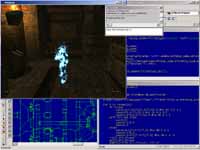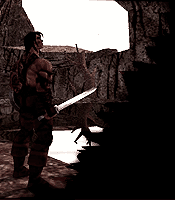| |
Special Effects Programmer: Manuel Ruiz Montes
Before working with Rebel Act I studied a science
degree in the Granada University (Spain). I've worked on Blade since
the very beginning (a long time ago, that is), when the whole thing
was a not a very defined project undertaken by a small group of
people. At the beginning I worked as a 3D graphic artist, but later
I got into level design and some programming too. Well, may be that's
why the call me Manolito++!
 Apart
from the game's window (winblade) and the console in the image,
you can see two other programs: Visual C++ in which you can see
a python file (to perform the scripts) and a C++ file (in which,
among other things, creates the python-engine interface). The second
program is the Level Editor; as a part of the scripts consist of
cinematic sequences integrated within the gameplay of a level, and
are performed completely in real time with the game's 3d-engine,
you often need to know some data about the level architecture. Apart
from the game's window (winblade) and the console in the image,
you can see two other programs: Visual C++ in which you can see
a python file (to perform the scripts) and a C++ file (in which,
among other things, creates the python-engine interface). The second
program is the Level Editor; as a part of the scripts consist of
cinematic sequences integrated within the gameplay of a level, and
are performed completely in real time with the game's 3d-engine,
you often need to know some data about the level architecture.
When we took this screenshot I was trying several
configurations of particle systems, in order to add a few magical
effects to the playing characters (in that given moment I was testing
it with the Amazon).
All the scripts, even the ones for special
effects, are written in python. In C++ we code all the different
kinds of entities (objects, persons, cameras, particle systems,
etc.), their several properties (that will influence in its behavior
and visualization), and all the functions to manipulate those entities.
Also done in C++ is the entire interface to deal with the entities
from Python (as mentioned).
As a 3d artist uses the tools of a 3d design
program to build objects, I use all the tools the engine provides
me to represent the different sequences and special effects that
appears on the screen along the game. For example, I am the one
who shapes up the chaos knight's missile, its visual aspect, the
effects linked to its appearing when the chaos knight concentrates
the energy needed for launching it, the visual effect of the hit
with the player, etc.
The main scheme of a FX-sequence is foreseen
beforehand and is being refined as it is done, specially the camera
movements, the several animations that the characters perform and/or
enemies that are implied in the scene, and the final aspect of the
visual effects that appear.
The field of application of special effects
is very wide and the system is so customizable that the possibilities
are almost infinite. Some examples, apart from the more obvious
ones (as making magic lighting and objects appearing etc.), are:
atmospheric effects, some kinds of traps, the majority of the magical
blocks and attacks, object morphing, energy concentration effect
and energy dispels effects, electric bolts, appearing and disappearing
of certain enemies etc.
All the special effects are done using the
own entities of the engine, along with their specific settings and
a placement within the game space completely defined, which interacts
perfectly with the other elements on the screen. That's why the
use of layers is unnecessary.
As I mentioned, all the entities (and the objects
are just one kind of the ones available in Blade) have several properties
that influence in their behavior and visualization. For example,
in the case of a 3d object that magically appears the effect is
performed manipulating, in real time, several properties of the
object, like the transparency/alpha level, the kind of transparency
(additive, alpha blending, etc), the level of self-illumination
of the object's texture, its scale, etc. All this is combined with
other entities like light sources, particle systems, electric bolts,
etc. to give the final touch.
The particle systems are one of the entities
with the higher number of attributes or properties, which a lot
of different effects can be achieved. Without getting too technical
I can tell you that the whole definition of a particle system consists
of two sets: 1) The aspect of the particle itself along its lifetime
is defined. During that time its colour, transparency, size, etc.
can vary as desired. 2) On the other hand, the properties of the
system itself are manipulated. Such as the kind of particle to be
used of the ones defined previously, the gravity, several types
of velocity, the living time of the particles generated, the time
to live of the system itself, the friction with the air, the tendency
of the particles to follow the particle's source generator movement
if this one moves in the space (making a more or less noticeable
trail effect if wanted), the kind of source that generates those
particles (which can be either a point, a line, an area or even
all the vertices of an object's mesh or character), etc.
The use of special effects along the game is
not isolated to a few moments. On the contrary, they are present
along all the flow of the action, sometimes in small doses (for
not being annoying), while other times in a higher scale (for example
in some scenes of major importance).
The fact that the special effects being calculated
in real time make them useful not only for adding spectacularly
to a lot of the scripted sequences present along the game, but also
to provide a clearer information to the player. I mean, a visual
effect can be used to indicate the player when he has raised his
level (not just using a simple number), when he is under the effect
of a given potion, when there is a magical weapon, when a given
enemy is about to launch a magical attack, etc. In fact, objects
like torches, candles, lamps, etc are built with the 3d model, which
has got a light entity and a particle system linked. Those entities
are exactly the same that are used to create more complex special
effects and are done without stopping the action at all.
We take special care with the system-resource
usage, because a visual effect is created so it can be seen properly
and a low framerate will cause a negative impression. The major
problems were in the lack of proper dealing with transparencies
of certain 3d cards that are currently obsoletes (like the voodoo
1), but those problems were overcome in more recent cards (just
like a voodoo 2, that works much better than a voodoo1 in that field).
The background for FX in both games and movies
are the same, but the way of working differs, as the possible problems
that can arise. That's because a lot of the special effects used
in movies are edited in postproduction over a 2D image, so the quality
of the effect is affected in a big way by the good or bad integration
with the real image. This is a problem that almost does not exist
in a videogame, allowing us to explore many possibilities in small
time frames working straight with the final "cut", but
- on the other hand we are somehow limited by the engine's capabilities.
Without giving less credit to other games (take
into account that many of us are die-hard players and we also enjoy
and get surprised with other games), I think that the plot unfolding
and the diversity in the action in Blade will make it one of the
current games with more diversity and spectacular in its visual
effects, without draining a single bit from the gameplay.
Previous
| Index | Next
|
|





